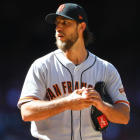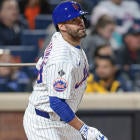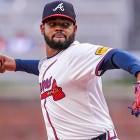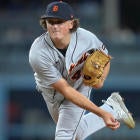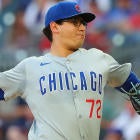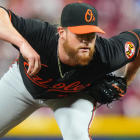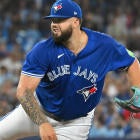Welcome to our 2019 Player Profiles series. We are going through the top-300 in Heath Cummings and Scott White's consensus rankings to give you the case for and the case against drafting each player. By the time you're done, you'll know everything you need to know for drafting in 2019.
Player Rankings: 1-10 | 11-20 | 21-30 | 31-40 | 41-50 | 51-60 | 61-70 | 71-80 | 81-90 | 91-100 | 101-110 | 111-120 | 121-130 | 131-140 | 141-150 | 151-160 | 161-170 | 171-180 | 181-190 | 191-200 | 201-210 | 211-220 | 221-230 | 231-240 | 241-250 | 251-260 | 261-270 | 271-280 | 281-290 | 291-300
81. Jesus Aguilar, 1B, Brewers
The Case For: Aguilar went from a useful power bat off the bench to a legitimate Fantasy force in 2018, emerging as an everyday player and middle-of-the-order power hitter. He cut his strikeout rate down to 25.3 percent while maintaining his ability to clobber the ball, helping him emerge as a possible successor to Nelson Cruz's throne among beefy right-handed mashers. And the underlying skills back it up, as Aguilar hit the ball hard and hit it in the air often, the right combination to bet on. His full 2018 contributions aren't being factored into his price, making him a potential bargain for the true believers.
The Case Against: As with all late-career breakouts, the question is whether he can sustain it. Can Aguilar be another J.D. Martinez type, or is he the next Justin Smoak/Justin Boar/Yonder Alonso flash in the pan? The advanced stats back it up, but they did for Smoak/Bour/Alonso too, and none of them lived up to expectations in 2018. Add in Aguilar's second-half swoon, and this looks like a risky bet.
82. Nelson Cruz, DH, Twins
The Case For: Five years in a row of at least 37 homers and 93 RBI. No sign of decline in his batted-ball or contact skills. Even if the top-line numbers were down just a little bit (mostly with his .256 average, his lowest since 2007), Cruz largely looked like the same incredible hitter he's been for the past half-decade.
The Case Against: It's the same with any player at this stage in his career: There's just no way of knowing when the bottom will fall out. Cruz turns 39 midseason, and the list of players who have managed at least an .850 OPS while qualifying for the batting title at 38 or older in the past 20 years is just 11 players long. It's not impossible that Cruz keeps this up obviously — 38 is only one year older than 37, after all! — but the odds get increasingly long with each passing year.
83. Madison Bumgarner, SP, Giants
The Case For: Even while dealing with injuries, Bumgarner has put together a 3.29 ERA and 1.17 WHIP over the past two years, while averaging 6.1 innings per start. We can talk about Bumgarner's apparently declining skill set all we want, but the fact of the matter is when he's been on the mound, he's been an effective workhorse, and he still pitches in one of the great pitching environments in baseball.
The Case Against: His skillset is declining, however. Bumgarner went from five straight seasons with a FIP below 3.50 to two consecutive seasons at 4.19 and 3.99. The finger injury he suffered in 2018 isn't a long-term concern, but the shoulder injury he dealt with in 2017 seems to have knocked Bumgarner off course. The question, however, is whether that's permanent. Is he worth this price to find out?
84. Kenley Jansen, RP, Dodgers
The Case For: Jansen faces the opposite question that Treinen does: Were his struggles in 2018 just a blip, or the beginning of his time as an also-ran at the position? I'm willing to bet it's the latter. There were reasons to panic about Jansen early on, when the velocity on his cutter was way down after a shortened spring training. By the end of his seventh outing of the year, he had allowed three home runs in 6.2 innings, while striking out just 22.5 percent of opposing batters. He got most of the way back to his usually dominant self over the next few months, sporting a 1.41 ERA, 28.9 K%, and 5.9 BB% from May 1 through Aug. 7, before his season was knocked off course by an ongoing heart issue. He struggled from then on, but was fine in the playoffs. Hopefully, after having surgery in the offseason to deal with his atrial fibrillation issue, Jansen will be back and as good as ever in 2019.
The Case Against: Jansen's approach to pitching has never been particularly complicated. I'm not even sure he and the catcher need signs — what's the sign for "Just throw your cutter a bunch, man" anyways? He has thrown that pitch between 84 and 94 percent of the time, and it's not clear he has an answer for what happens if it loses effectiveness. He can throw his fastball and slider more, but I'm not sure that's a viable solution. Jansen's going to go as far as the cutter takes him. Given what we saw last year, there's no guarantee it takes him somewhere you want to be.
85. Dee Gordon, 2B/OF, Mariners
The Case For: As long as he keeps running, Gordon is going to have a pretty high floor, at least in Roto. Even while hitting just .268 with 30 steals in 2018 — his lowest full-season pace ever — Gordon was a top-175 player. That's not a stud, but it's also hard to see him having a worse season in 2019. 2018 was mostly a worst-case scenario for Gordon.
The Case Against: Players who rely primarily on their speed tend not to age well, and we might have seen the start of Gordon's decline phase in 2018. He attempted a steal on 21.1 percent of total opportunities, by far the lowest rate of his career. If that doesn't turn around, and Gordon continues to hit ninth in this lineup, he may be more like a sub-peak Ben Revere – not a particularly exciting Fantasy player.
86. Gleyber Torres, 2B/SS, Yankees
The Case For: A top prospect who put up a 162-game pace of .271-71-32-101-8 as a 21-year-old. What's not to like?
The Case Against: For one thing, the power probably wasn't real. Torres had a good-not-great 38.4 percent hard-hit rate, but ended up with a 17.9 percent HR/FB rate, a well-above-average mark. Yankee Stadium certainly helps, but Torres' 24 homers in 2018 were his career-high for a season by more than double. Torres is a talented hitter, but based on what he did in 2018, the hype is going to exceed what you can realistically expect from him.
87. German Marquez, SP, Rockies
The Case For: A couple of things came together for Marquez in the second half of 2018. His velocity climbed a bit, putting him in the elite class for starting pitchers, averaging 96-plus mph with his fastball in September. Perhaps most importantly, he started using his slider more, which turned out to be his best pitch in 2018. If the gains he made last season are real, Marquez could be a top-20 pitcher, even in Coors Field.
The Case Against: Of course, Coors can still ruin the best laid of plans, even for a talented pitcher. The work of 10 solid starts can be undone by two or three miserable ones, and the margin for error in Marquez's home park is miniscule. It's worth mentioning: During Marquez's 17-start stretch with a 2.47 ERA to close the season, he pitched at Coors only seven times. Marquez's upside is high, but there might be similar ceilings among pitchers drafted around the same spot or later, with higher floors.
88. Blake Treinen, RP, Athletics
The Case For: With the exception of a half-season in Washington in 2017, Treinen has been pretty consistently good for years, but 2018 was otherworldly. He added a cutter to his repertoire and just took off, inducing the highest percentage of swinging strikes in his career, while moving his walk rate down and his strikeout rate way up. His 0.78 ERA and 38 saves made him one of the best closers in baseball, and a 1.82 FIP and 2.46 SIERA back up that lofty rankings. He took the leap toward dominance.
The Case Against: Of course … doing it for one year isn't the problem. It's holding on to those gains and developing into a truly reliable, year-in, year-out source of dominance. Zach Britton followed up his 0.54 ERA season with an ERA nearly 2.5 runs higher, and he dealt with injuries and just hasn't looked the same. Did Treinen, at 30, just figure everything out all at once? Or is this another flash in the pan? I'm willing to bet it's the former, but it's hard to pay the price for an elite closer on someone who's only done it once.
89. Roberto Osuna, RP, Astros
The Case For: If you're looking for a potential candidate for the next Edwin Diaz, you could do worse than Osuna. He doesn't have quite the strikeout potential, but he had a 2.37 ERA in 2018, and has two consecutive seasons with a FIP below 2.50, an elite mark. He saw a spike in his swinging strike rate upon joining the Astros, and he picked up 12 saves from Aug. 22 through Sept. 28. A huge season could be in the offing for Osuna.
The Case Against: Despite the increase in swinging strikes, Osuna still didn't strike many batters out with the Astros, and his 21.3 percent strikeout rate overall is well below par for your typical closer. We also saw a stretch from him in 2017 where Osuna looked like he was coming off the rails, and his history of off-the-field issues are another red flag. When you're taking a closer in the top 100, you really need him to be dependable, and Osuna comes with plenty of red flags.
90. David Price, SP, Red Sox
The Case For: 2018 was a heck of a turnaround for David Price, who looked to be in major decline following a disappointing 2016 and injury-plagued 2017. However, he made 30 starts, struck out more than a batter per inning, and sported a 3.58 ERA in a real return to form. He'll probably never have his old velocity again, but Price has adapted by relying more on his off-speed pitches to keep hitters off balance. It works.
The Case Against: But it probably doesn't work enough to justify this draft ranking. Price's peripherals were actually largely worse than in his disappointing 2016, and he posted his worst swinging strike rate since 2013. Perhaps most disappointingly, the former workhorse averaged less than six innings per start. Even during his incredible second-half run (2.25 ERA in 11 starts), he just barely topped six innings per start. There are pitchers with more upside going after him, and he's no longer the safe pick either.
Player Rankings: 1-10 | 11-20 | 21-30 | 31-40 | 41-50 | 51-60 | 61-70 | 71-80 | 81-90 | 91-100 | 101-110 | 111-120 | 121-130 | 131-140 | 141-150 | 151-160 | 161-170 | 171-180 | 181-190 | 191-200 | 201-210 | 211-220 | 221-230 | 231-240 | 241-250 | 251-260 | 261-270 | 271-280 | 281-290 | 291-300













